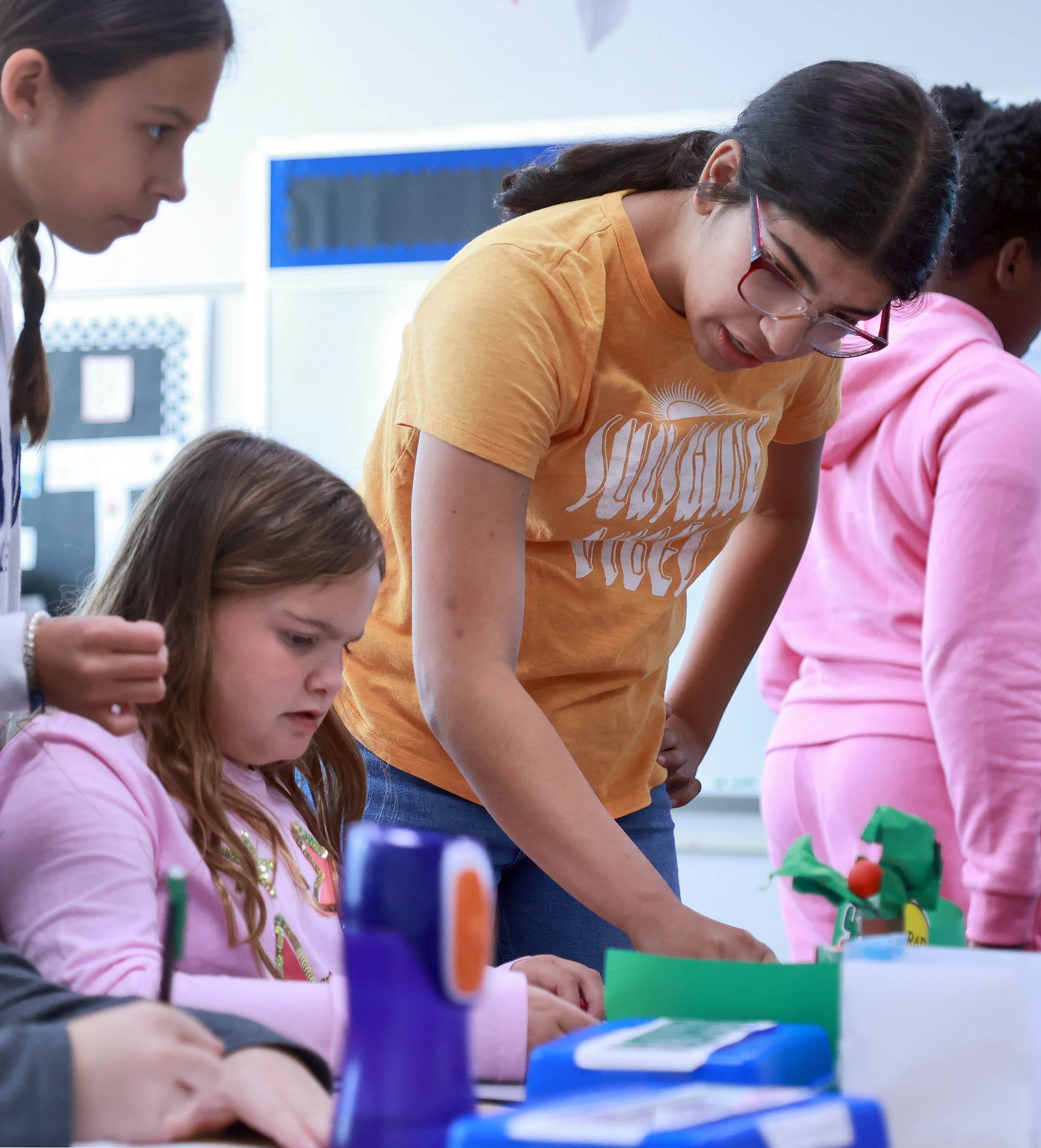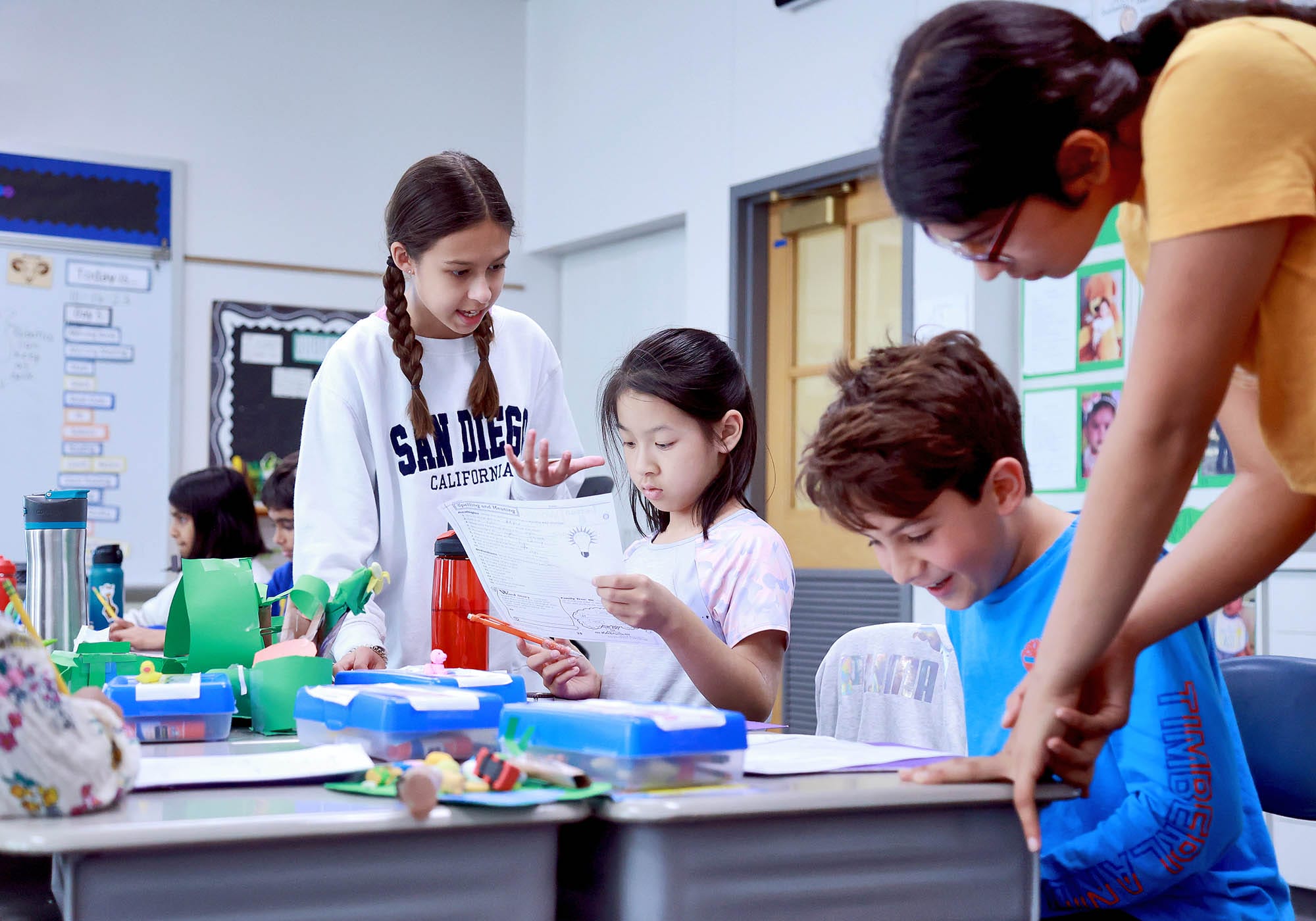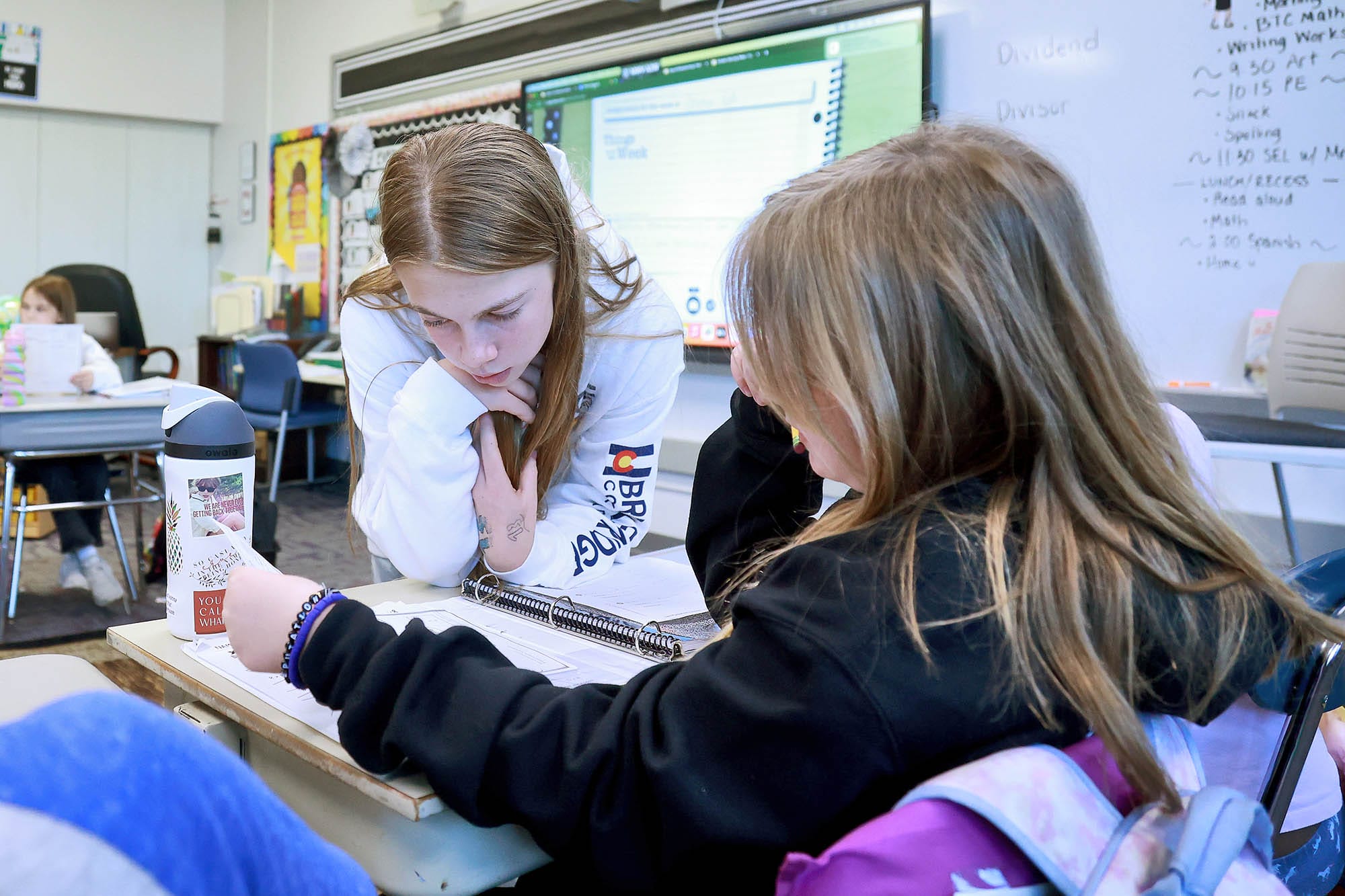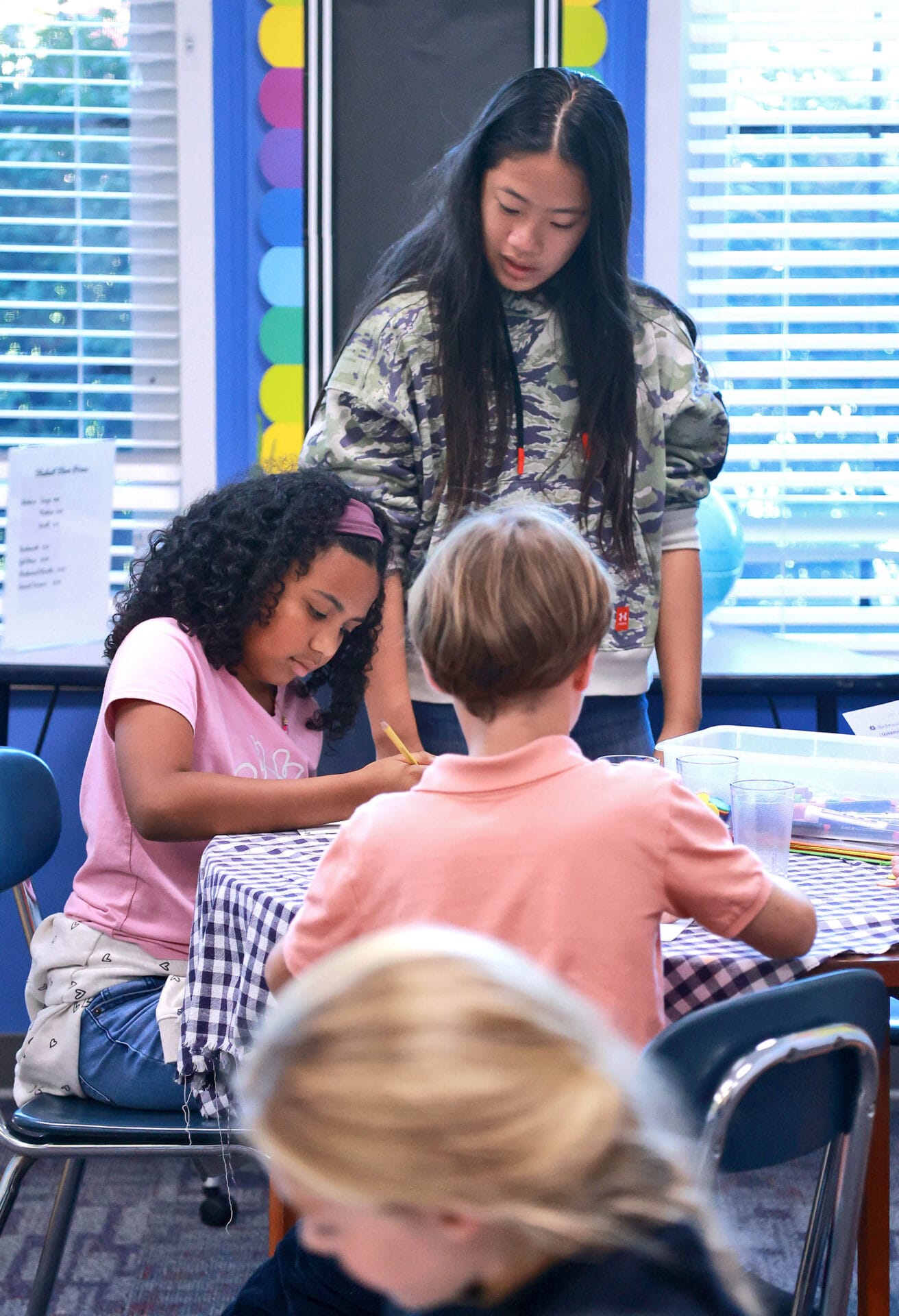«Let’s do this!»
Enthusiasm and a passion for motivating kids has led Seventh Grade Dean Eric Taylor since he hit the ground running this school year, and one of his pet projects has come to life: creating a small team of seventh-grade students to mentor their fourth-grade schoolmates in Beasley and build yet another bridge between Lower and Middle School.
Taylor credits Middle School Science Teacher and Community Coordinator Callie Bambenek with the initial idea. He had just started at MICDS over the summer and was learning about the Middle School LEAD initiative for students:
- Learn with curiosity and joy
- Embrace challenge
- Advocate for self and community
- Demonstrate collaboration and teamwork
«Part of the program talks about opportunities for grade levels to interact more,» he said. «We’re often in silos simply because of how the grade levels are organized on different floors.» He also considered how difficult community service has become since the pandemic, with a shortage of resources like bussing. Are there opportunities on our own campus? Bambenek mentioned that creating a connection between seventh-grade and fourth-grade students would be great for several reasons: the following year, both grades would be in the same division (as fifth- and eighth-graders), and the fourth-grade students don’t require as much handholding and can be more individually interactive. Taylor thought this was a great idea. He put together some rough notes and pitched them to Head of Lower School Amy Scheer. She connected him with our fourth-grade teaching team, who helped brainstorm how a mentoring program would work logistically, along with the types of interactions that would be most positive for both sets of students.
The team realized that seventh grade has occasional H Block mornings (used for flex or study hall) that make students available to visit fourth-grade classrooms and that Beasley mornings might be compatible, at least at first. Fourth-grade students start their day with a circle, sometimes doing a warm-up activity or a creative math project. The first sessions have been good get-to-know-you interactions, and Taylor is hopeful that his seventh-grade team will eventually be able to mentor their younger friends with organization skills and time management. «They’re like the teaching assistants for fourth grade,» he explained, «and it’s important that they build relationships.» He’s also counting on all-school events throughout the year, such as Turkey Train in November, to reinforce those bonds.
Taylor set some limits on this first year’s foray into mentorship. For example, only 12 mentor positions were offered, and seventh-graders had to apply. He presented the idea at a class meeting, and the response was outstanding: 30 students applied for the 12 positions, filling out a four-question application and explaining their motivations for wanting to serve. One student showed initiative by reaching out directly to the fourth-grade teachers and asking them about their expectations before completing his application. Taylor was impressed by his thoughtfulness, and enjoyed reading all the applications. «One student mentor is very quiet, but her reason for applying is that she’s trying to push herself to be more outgoing and work with students she might not normally interact with,» he said. The application pool included a wide array of students from different group dynamics and social groups.
Mrinali Kaswan ’29 explained that she loves to work with kids, and already has experience! She wrote, «I have a younger brother who is in third grade. I help him with his homework a lot.» She is looking forward to helping her mentees learn LEAD and good study habits.
Beau Bergquist ’29 also cites his experience with a younger sibling on his application. He shared, «At my old school I would always go and help the lower school after-school program if they needed it.» He wrote that he’s great at math, and envisions teaching his mentees school traditions like not stepping on the seal.
Cece Mileusnic ’29 wants to help younger students become comfortable interacting with other students who may be older, and helping them get a feel for the Middle School. «I hope to become someone they look forward to seeing,» she wrote.
Garryn Jackson ’29 is a Rambassador, and learned through that experience that she enjoys meeting new people, especially younger students. She’s astute about her strengths, saying, «I can read a room and tell what energy to use and what energy not to use.» She’s also hoping to learn from her charges, perhaps exploring different cultures and new ways of thinking.
Zara Mahmud ’29 has set some great goals for her mentorship. «I envision making a positive impact as a mentor by showing the younger kids ways to work together, be kind, be a leader, try their best, and work hard.» With three younger siblings, she’s already got great experience!
Trey Wyckoff ’29 made an excellent point in his application. «I did the fourth-graders’ work three years ago,» he wrote, «but if their parents are helping them, they might not remember everything because they were in fourth grade a long time ago.» He’s also going to strive to ensure everyone feels included.
Most of the applications were really meaningful, and Taylor had to do the hard work of selecting only 12. That team began their work by discussing what it means to be a mentor and what it would actually look like in a Beasley classroom. «We are not seventh-grade buddies,» Taylor was careful to stress. «We’re not going into this to simply be friends with the kids. You are teaching assistants; you’re going to model what it’s like to be mature students, and you’ll be ‘experts’ in math and English. Stay focused on helping guide the students!»
Their first morning with their fourth-grade charges was filled with smiles and fun. By the second session, both groups of students were more relaxed and at ease with each other, setting the foundation for a great year of mentorship and partnership. Taylor continues to plan future sessions, always using H Block to ensure seventh-grade students don’t miss classes but exploring both morning and afternoon opportunities. He’s also eager to create more opportunities for seventh-graders since there are so many interested students.
Well done, mentors! Keep being positive role models for your younger schoolmates!




